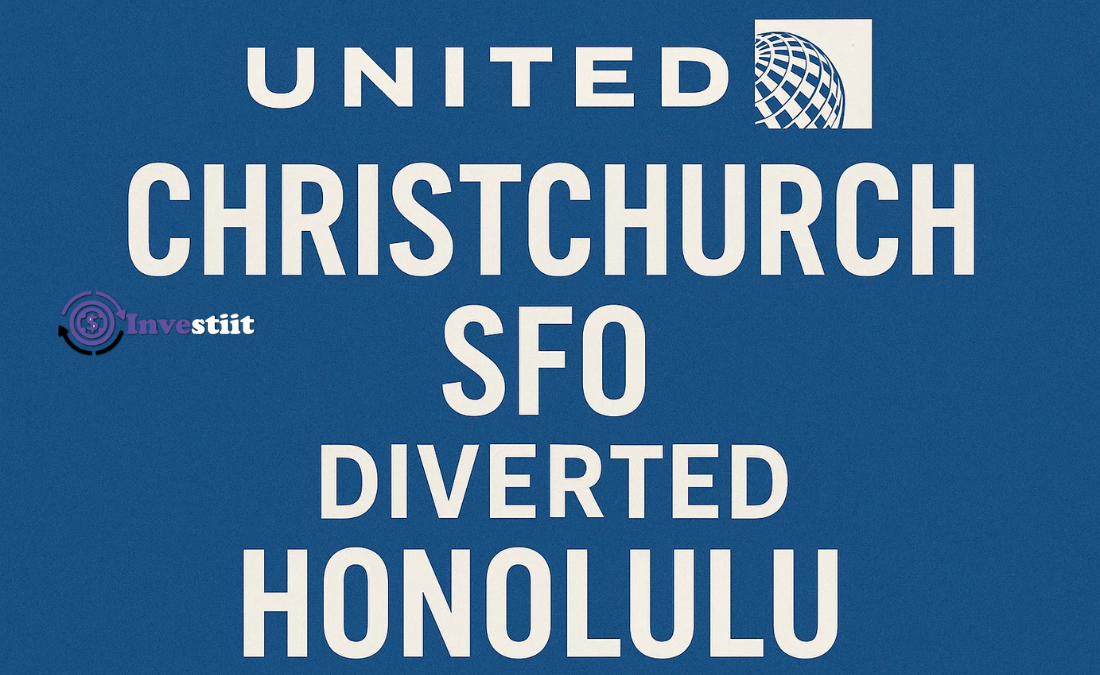Introduction
The phrase “United Christchurch SFO diverted Honolulu” describes a recent aviation incident that caught the attention of many travelers and aviation enthusiasts. A long-haul United Airlines flight traveling from Christchurch, New Zealand (CHC), to San Francisco, California (SFO), was unexpectedly diverted to Honolulu, Hawaii (HNL). While diversions are not uncommon in global aviation, one occurring on a major trans-Pacific route raises many questions about what happened, why it happened, and how it was managed.
This article provides a detailed look at the event, the reasons behind it, and its implications for both passengers and the airline industry.
The United Christchurch to SFO Route
The route from Christchurch to San Francisco is one of United Airlines’ longest non-stop connections across the Pacific Ocean. The flight usually covers more than 10,000 kilometers and lasts about 13 hours. It connects the South Island of New Zealand directly to the United States, serving as a key link for business, tourism, and family travel.
United introduced this route to expand its trans-Pacific network, allowing travelers from New Zealand to reach major U.S. destinations conveniently without connecting through Auckland or Sydney. The flight uses the Boeing 787 Dreamliner, an aircraft designed specifically for ultra-long-range flights with advanced fuel efficiency and passenger comfort.
Given the complexity of such a route, every flight must be planned with precision — including alternate airports, weather forecasts, and crew schedules. That’s why the unexpected United Christchurch SFO diverted Honolulu event drew such attention.
What Happened: United Christchurch SFO Diverted Honolulu
On the day of the incident, a United Airlines Boeing 787 departed Christchurch on schedule for San Francisco. The flight initially proceeded normally, but a few hours into the journey, the aircraft was rerouted to Honolulu International Airport in Hawaii.
Instead of landing at its intended destination of San Francisco, the flight touched down safely in Honolulu. Passengers were informed during the flight that a diversion was necessary. Upon landing, travelers were rebooked on later flights to complete their journey to San Francisco.
While diversions may sound dramatic, they are a routine safety procedure when airlines encounter unforeseen operational issues.
Reasons Behind the Diversion
1. Crew Duty Time Limits
One of the most likely reasons for the diversion was crew duty-time limits. In commercial aviation, pilots and flight attendants are subject to strict regulations regarding how long they can work without rest. These rules are designed to prevent fatigue and ensure maximum safety during flight operations.
If delays occur before or during the journey — due to weather, maintenance, or scheduling issues — crews can reach the maximum number of hours they are legally allowed to operate. When this happens, continuing to the original destination becomes impossible without breaking aviation safety laws.
In such a case, diverting to a closer airport like Honolulu allows the airline to change crews, rest the existing ones, and continue the flight safely later.
2. Possible Technical or Operational Concerns
Another potential reason for the diversion may have been technical or operational issues with the aircraft. Even a minor irregularity on a long over-water route can lead to a precautionary diversion. Because large parts of the Pacific Ocean lack nearby airports, pilots must make early decisions if they suspect any potential problem that could worsen mid-flight.
3. Weather and Routing Factors
Pacific weather patterns can also impact flight paths. Strong headwinds, turbulence, or volcanic activity sometimes prompt changes in routing. Honolulu serves as a convenient and well-equipped diversion airport for such situations.
Why Honolulu Was Chosen
Honolulu International Airport (HNL) is one of the main diversion and refueling stops for trans-Pacific flights. Its strategic mid-Pacific location makes it ideal for aircraft flying between Oceania and North America.
There are several key reasons United Airlines likely chose Honolulu for the diversion:
- Safety and proximity: It was the closest major airport along the flight’s path that could handle a large Boeing 787 Dreamliner.
- United Airlines presence: United has operations in Honolulu, which means maintenance crews, ground staff, and logistical support are available.
- Passenger convenience: Honolulu provides comfortable facilities, hotels, and onward flight options for passengers needing rebooking.
By diverting to Honolulu, the airline ensured the passengers’ safety while minimizing disruption to the rest of the route.
Passenger Experience
Passengers on the United Christchurch SFO diverted Honolulu flight experienced an unexpected stopover in Hawaii. Although it disrupted their travel plans, the airline’s handling of the situation was generally efficient.
Upon landing, travelers were informed of the situation, offered assistance, and rebooked on later flights to San Francisco. For many, this meant a few extra hours of waiting — and an unplanned but scenic view of Honolulu.
While such situations can be frustrating, most passengers appreciate when safety comes first. A diversion due to crew hours or technical issues is a sign that the airline prioritizes compliance and well-being over convenience.
The Role of Crew Regulations
To understand the event better, it’s important to look at crew duty regulations.
Under international aviation laws, pilots are allowed to fly a specific number of hours within a given period. Exceeding those limits is illegal and unsafe, as fatigue can severely impact reaction time and decision-making ability.
For long-haul flights like Christchurch to San Francisco, crews often operate near their maximum allowable hours. Delays during takeoff or en route can tip them over that limit. If that happens mid-flight, they must divert to an intermediate airport where a new, rested crew can take over.
This strict regulation is one of the reasons commercial air travel remains the safest mode of transportation in the world.
Operational Implications for United Airlines
A diversion like this doesn’t only affect passengers — it also has logistical and financial impacts for the airline.
- Scheduling: The aircraft and crew need to be rescheduled for future flights.
- Cost: Diversions lead to additional fuel consumption, airport handling charges, hotel accommodations, and rebooking expenses.
- Aircraft maintenance: If the diversion was due to a mechanical issue, the plane must undergo thorough inspections before resuming operations.
Despite the costs, airlines follow a “safety first” philosophy. Continuing a flight under non-ideal conditions could lead to far greater consequences.

Industry Reactions and Safety Culture
The United Christchurch SFO diverted Honolulu event highlights how well modern aviation safety systems work.
Instead of taking risks, airlines now have clearly defined decision-making frameworks. Pilots receive constant updates from dispatchers, meteorologists, and engineers during long flights. If any issue arises — whether technical, regulatory, or medical — the airline responds swiftly to ensure safety.
Such events also showcase how reliable modern aircraft are. Even with thousands of flights crossing oceans daily, diversions remain rare and are almost always precautionary rather than emergency landings.
Lessons for Passengers
For passengers, this incident serves as a reminder that aviation is built on a foundation of safety over schedule. Some key takeaways include:
- Diversions are normal safety measures, not signs of failure.
- Crew fatigue management is essential — passengers want pilots who are alert and rested.
- Always keep travel flexibility in mind, especially on ultra-long-haul routes.
- Airlines will take care of rebooking and accommodation, so it’s best to remain calm and cooperative.
Understanding these realities can make diversions less stressful and more understandable when they happen.
Broader Importance of Trans-Pacific Operations
Flights like Christchurch to San Francisco are complex feats of modern engineering and coordination. They involve multiple time zones, weather systems, and international regulations.
The fact that an aircraft can fly halfway around the world safely, even when unexpected events occur, is a testament to aviation technology and human professionalism. Honolulu’s role as a diversion point further demonstrates how prepared the industry is for any contingency.
Conclusion
The United Christchurch SFO diverted Honolulu incident may have disrupted travel plans for hundreds of passengers, but it also underscored the resilience and safety-first mindset of modern air travel.
Whether the cause was crew duty-hour limitations, operational constraints, or technical precautions, the outcome showed that United Airlines and its flight crew made the right decision. By diverting to Honolulu, they ensured that passengers and crew remained safe and that regulations were fully respected.
In the end, while diversions can be inconvenient, they remind us of one essential truth: in aviation, safety always comes before schedule. The United Christchurch SFO diverted Honolulu story stands as a perfect example of how the aviation industry continues to uphold that commitment every single day.


